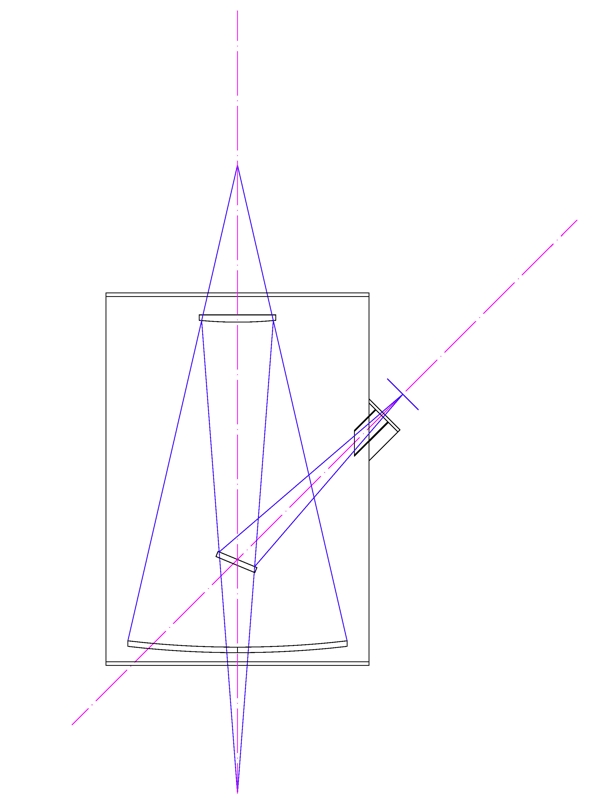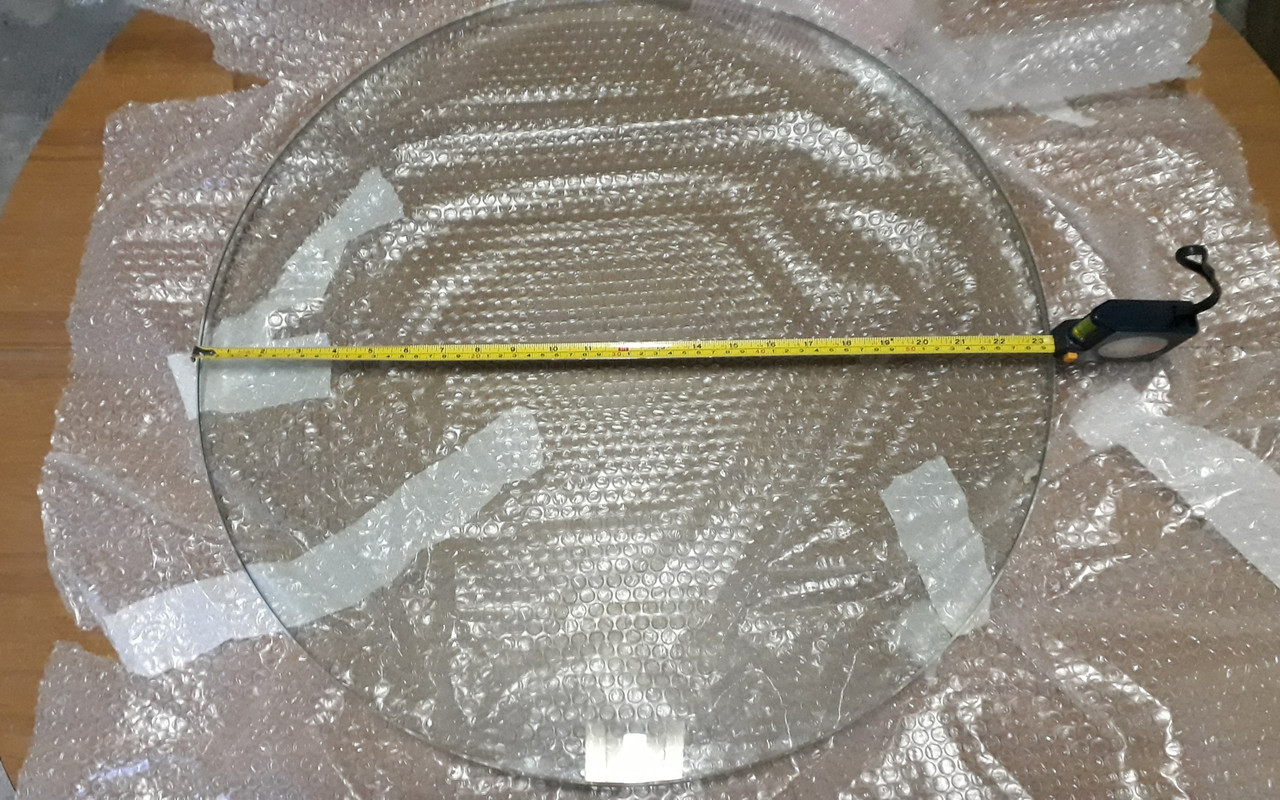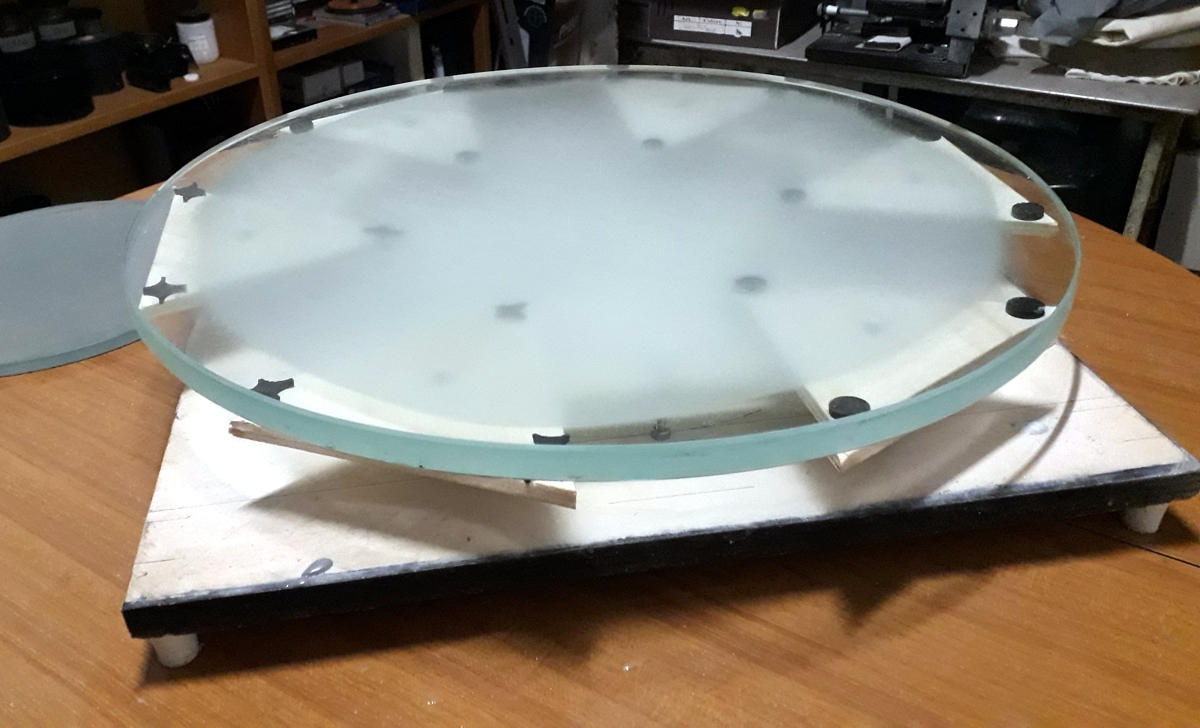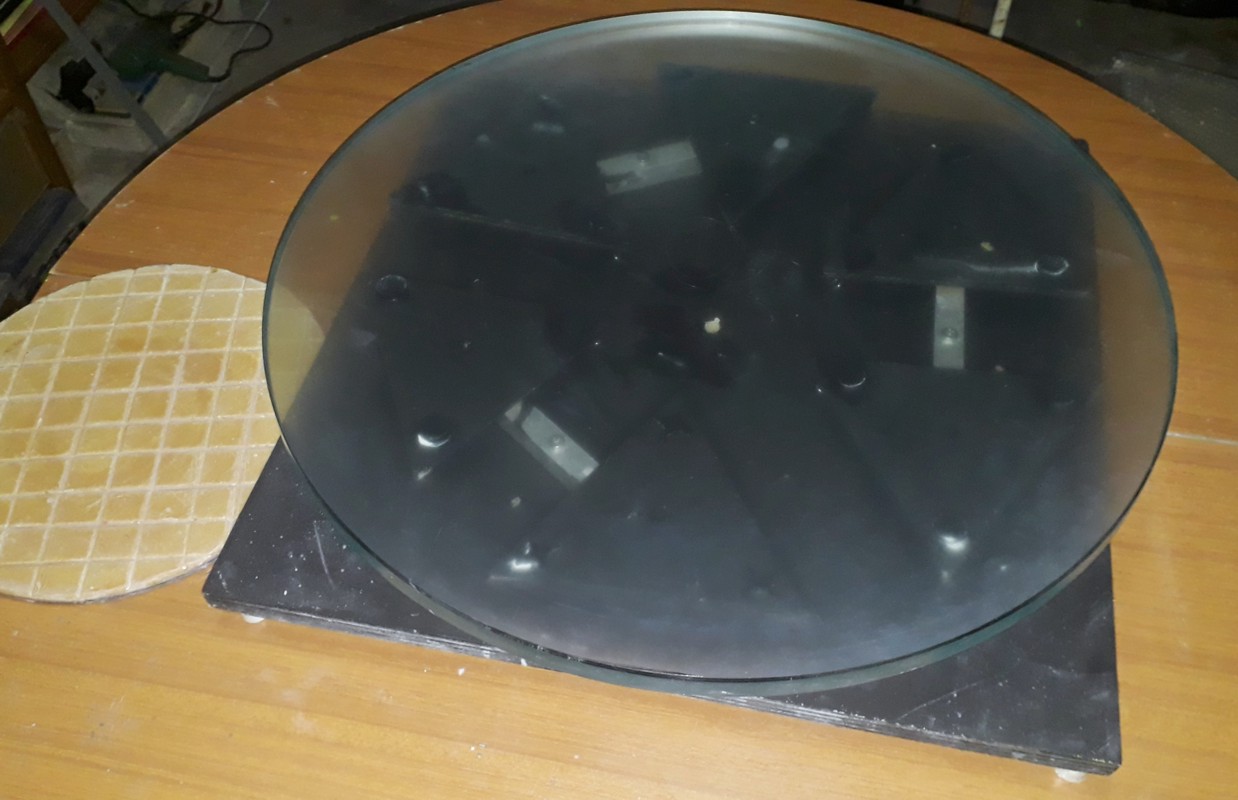- This topic has 71 replies, 5 voices, and was last updated 3 years, 4 months ago by
Bartolomei Mirco.
-
AuthorPosts
-
14 January 2020 at 18:29 #11659
Finally it resumes to scratch !

This time the project is "experimental", in the sense that we are going to work a blank in the meniscus of calcium-sodium very thin glass, with a very short focal ratio.
There is no reliable data on the potential and usability / reliability of such a mirror, despite some manufacturers from across the ocean assert that "they are going great", So here we are ready to study what will come out.
THE PROJECT:
the purpose is that of realizing a "Dobson style" telescope that is a generous diameter, compact, light, transportable and sitting comfortably on a human eye height ... in practice the dream of any visualist.
It 'clear that some compromises have to accept, you can not have everything ...
But let the project data:
Optical Pattern Ritchey-Chretien F6.6 with fire Nasmyth.
primary mirror: meniscus, diameter 600 mm, constant thickness 20 mm, F2.2 hyperbolic profile with K = -1.10
hyperbolic secondary mirror diameter 200 mm F -3.25 K= -5.11
tertiary diameter plane mirror 110 mm
Distance primary-secondary mirror 890 mm for a total length of the "tube / trellis" of 1020 mm
Maximum eye-Ground clearance 1.25 m, minimum 0.95 m
We will be able to enter the construction details of the later telescope, for now we start with the processing of the primary, There will in fact be, before they begin, to solve some of the problems that arise when the surface of the blank support is not flat, as usually happens, but curve.
in the meantime, here is from the meniscus 60 cm just "discarded". 20 January 2020 at 14:00 #11664
20 January 2020 at 14:00 #11664Oooooh Very Massimo

As far as I can see, This time you decided to embark on a more ambitious project that
I can not wait to follow step by step progress, and see how you can solve, the inevitable problems that will crop up with a project of this size.
See you soon and good work!!!20 January 2020 at 15:24 #11665Thanks Mirco, In fact, the first problem is one of those where your opinion and that of Giulio might be enlightening.
Put simply: where we caspita support him the mirror for processing ?”
Said in a less simple: the cell “standard”, that designed with Plop, It may be valid also for a curved support surface ? with which criteria can be evaluated where and how to intervene to modify / optimize a standard cell to host a mirror meniscus ( moreover thin ) ?
I also thought of making a plaster base, obtaining the mold directly on the meniscus, but this, assuming it is effective, only the problem of shift at the end of machining cell. So while I started to build a normal cell, as if it were the mirror plane, then.. let's see what happens, something we invent 25 January 2020 at 11:08 #11666
25 January 2020 at 11:08 #11666Hi guys
The solution to realize reflective mirrors with a meniscus of commercial glass thickness 20mm, for its softening and sagging on a curved surface, solves the problem of large excavation that would be necessary in the glass. But then on the meniscus need to work polishing and parabolizzazione, and then serve a support able to bring the flat rear surface of the meniscus curve, possibly, if combined with the mirror glass, that is, without inducing therein the constraints that generate higher deformations to 68,75 nanometers high., dates from different coefficient of thermal expansion.I find myself accustomed to the practice of brainstorming, and I read some time building insulation FOAMGLASS, albeit in reference to uses different from those optical…because from experience, poprio in remote areas have often found the neighbors problems solutions.
I had seen on YouTube videos that the brick structure of the closed alveoli FOAMGLASS, It makes shearable freehand with a wooden ripsaw, and then I imagine that it can not be difficult to be machined to achieve the concave support excavation for a meniscus (… with classical abrasion, or milling, or other).
The mechanical-thermal validity of the support for the machining of parabolizzazione (or as rear face coupled to the mirror) I think it would good for lightness, strength, absence of elasticity, and thermal expansion equal to that of glass.
The specific weight of 100kg per cubic meter is FOAMGLASS, that is 26 times less than normal glass which is of 2600kg per cubic meter.I also think that one of the problems could possibly be the type of “glue” to join the meniscus to the rear base support, so probably respectful of optical tolerances.
And here I would find interesting to try with the usual pitch, which it is always a mechanical interface for machining of optical lenses, with it fixed on the supports of figuration / polishing machines.
The pitch is a parent of carbon fiber in large quantities, and therefore also has very low expansion; and as the glass is a ritenibile “liquid” solid at room temperature (it is instructive to know the following experiment of its “slow speed” sliding caused by simple gravity https://it.wikipedia.org/wiki/Esperimento_…_goccia_di_pece)Besides, there are around glued working doublets with pitch for centuries, that if conditioning between two surfaces, by capillarity keeps almost forever its bearing characteristics not coercive.
The implementation will be interesting and not easy. But beyond the chatter of my, in my opinion (it is not a contract, but a trial) agree to take the simplest ways that there will be in the street mind facendo..come realize the plaster support such, because there is always time to correct errors as they arise, without “fasciarci head until it has been broken”.
25 January 2020 at 19:12 #11668Giulio, Waiting to understand how to design / build what you suggest
 , I built a cell "on the fly", very safe, just enough to rest the meniscus will start to see what and how you will be working.
, I built a cell "on the fly", very safe, just enough to rest the meniscus will start to see what and how you will be working. As I thought after a glance, just mirroring myself on the glass, despite the softening of the mold, the surface is far from being a sphere. At first it seems a ball, perhaps as a "piece of furniture" could also go through spherical, but for what you need us we are far.
I wanted to build me a suitable tool, but by chance I saw that I had the tool of 300 mm has almost the same curvature of the meniscus. By supporting the tool on the meniscus the edge remains raised approximately 1 mm.
But even the meniscus gave the impression of having a more pronounced curvature in the middle and not at the edge, as if the central zone had managed to fall by gravity to the mold during the softening, better than he had the edge.So I thought the ball was still standardized starting dall'abrasivo 80, better with a tool a bit 'more "curved", so that the various zonal curvature of the meniscus would soon be standardized with that tool, which would be completed starting from the center and not from the edges, without, however, altering the overall arrow ( almost ).
In the picture, the "improvised and temporary cell", of simple multi anyway after hearing that he thought Plop. To the right of the surface after 2 dried with 80.

It is seen in fact that a crown of about 4 centimeters to the edge, It remained lucid because it is not achieved by processing. The center is "touched" by the tool while the median-outer zone is the one that has longer need to be processed and that further undergoes the action of the tool.
After three sessions, the tool is adapted to the meniscus for a little more than half of the diameter, but the progression seems to be fast enough. In fact, from the first to the sixth dried, the contact surface between the two panes is passed from 50-60 mm to initial 160 mm dell’ultima.27 January 2020 at 9:25 #11669Good job in the cell Massimo!
The grit 80 It makes its way in a hurry, and processing in the robust cell is the solution that comes to mind first.When the meniscus, I would say that in any mechanical disc of any printed material or limp to “bowl” mentenendo the same original uniform thickness, stiffens.
There is always time to do experiments on the substrate.
Experiments that would see well only to verify if done with mass material inifinitesima and equal coefficient of expansion, It may prove to be somewhat equivalent to the mechanical construction of more technological cell. And then check if its construction is not “difficult”, according to “mission” and the thought of John Dobson tended to combine simplicity with functionality, and then be extended to these difficult optics.27 January 2020 at 20:56 #11672Thanks Giulio
But I think that the cell will magazine, perhaps it serves the aluminum of suitable thickness in place of wood, especially on the bars that support the triangles, otherwise you can not load weight on the tool during machining because flex at the ends, slightly but for the moment should "light" to go without relying too much on the tool… I do not know, it is better to give more thickness to multilayer or go directly on aluminum ?The meniscus is still out of the oven quite battered
 ( optically speaking ) , I do not deny that before starting I thought "how nice it starts directly to regularize the ball with patina and cerium"
( optically speaking ) , I do not deny that before starting I thought "how nice it starts directly to regularize the ball with patina and cerium"  but the illusion is very little time.
but the illusion is very little time.
Astigmatisms and many areas outside figure with a "p / v" estimated slightly lower than the millimeter.
But, I enjoyed it possible to "map" the mirror during processing with 80, at some points when the tool is "impuntava" in the moment that touched the highest areas and in other slipped away…
This was the situation in the first passes with 80, so I had to first return to the figure symmetry, working on the center median zones, trying not to change the overall depth if not strictly necessary.
Now the mirror is spherical ( relatively all'abrasivo 80 ) with a good symmetry up to 4 cm from the edge. At this point you can extend the processing to get to regularize the border, and then around the meniscus.

When the meniscus, I would say that in any mechanical disc of any printed material or limp to "bowl" mentenendo the same original uniform thickness, stiffens.
But in fact! It is what I think so too… Here it would like Mirco that gives us a nice calculation on the deformation of a meniscus, so let's see if we're right and how much

 27 January 2020 at 22:52 #11673
27 January 2020 at 22:52 #11673Hi Massimo,
Ohhh great, I see that the work is progressing
We say that not surprise me at all that the meniscus is not curved so smoothly during the softening in the oven. It happened to me too, when I tried to make the blank lightweight, you see:https://www.grattavetro.it/forums/topic/primario-420mm-foca/page/2/
In any case, returning to the question deformations, we say that does not change much from a disc or a meniscus curved, and this is due primarily to the fact that the curvature of which we are talking about is not so accentuated. I can also tell you that in the first approximation the cell that generates you Gui Plop, You can be considered valid also for your mirror meniscus.
That said you consiglerei to try to generate two types of cells, An A 18 points and a 27. Then just I have a moment, I try to make the most precise calculations, using these cells, inclinations to Vaie.But as for the cell you're using now, during processing, and, I would definitely recommend to realize a much more robust, aluminum or steel.
Hello and see you soon
Mirco 27 January 2020 at 23:23 #11677
27 January 2020 at 23:23 #11677hello Mirco, I saw that discussion… what a pity, sorry even now, It was really a great job !
About Plop, what do not understand is what thickness should be considered for the calculation. Pretending that the meniscus is a blank plan, to have almost uniform thickness should set a radius of a few dozen meters. Otherwise, inserting the real radius + thickness, Plop “thinks” I have left only 1,5 millimeters thick at the center … 27 January 2020 at 23:49 #11678
27 January 2020 at 23:49 #11678It Massimo Gui plop, probably it has limitations.
Look, while I would try to put a long loooong focal, in such a way as to simulate a virtually constant thickness blank, as has incidentally your meniscus.19 April 2020 at 23:51 #11715Resumption of processing , finished the sanding with grain 800 and the first three polishing sessions.
This is the mirror at the end of the processing with the grain 800:
The most difficult thing was to correct the initial astigmatism of the meniscus
 The softening on the mold had generated a shape far from the sphere and, if with a full diameter tool, reaching the spherical shape during grinding is quite easy, with a sub-diameter tool at 50% everything becomes much more complicated… moreover without being able to carry out checks on the surface, if you don't measure with the spherometer ( I have not done ) or the focal size with the wet mirror ( that I did instead
The softening on the mold had generated a shape far from the sphere and, if with a full diameter tool, reaching the spherical shape during grinding is quite easy, with a sub-diameter tool at 50% everything becomes much more complicated… moreover without being able to carry out checks on the surface, if you don't measure with the spherometer ( I have not done ) or the focal size with the wet mirror ( that I did instead  )
)
To give an idea , consider that at the beginning, with the wet mirror and the relative reflection of the light source, four bright spots formed in an area of a few square centimeters, of which a couple in focus while the others are not.
With grana 400 I had come to see only one stretched spot, while at the end of the 600 the spot had finally become one and circular like the source.
So I started polishing with the same sub-diameter at 50%. If astigmatism has completely disappeared, the first tests on the surface will finally tell us that it is starting to be reflective. 20 April 2020 at 0:37 #11716
20 April 2020 at 0:37 #11716Ehilaaaa great Massimo
 I follow with interest
I follow with interest 
Of course it's a nice beast!
I can't wait to see the first ronchi
Good continuation21 April 2020 at 16:14 #11726Nice job Massimo!
John Dobson's survatura and astigmatism verification system is excellent!!
 23 April 2020 at 23:52 #11735
23 April 2020 at 23:52 #11735Giulio, Thanks Mirco !

I built a “perch” to support the mirror, on the style of the one described in Mirco's article, minimalist and essential with “components” obtained from the banks of an old Ikea bed
to support the mirror, on the style of the one described in Mirco's article, minimalist and essential with “components” obtained from the banks of an old Ikea bed  with the addition of a spring screw on the upper stop, in order to have po’ of inclination adjustment.
with the addition of a spring screw on the upper stop, in order to have po’ of inclination adjustment.
Unfortunately, by a Rochi made on the fly, it turns out that the surface is still astigmatic ! It is not the extent of the deformation that worries me but the method to be used to uniform the radii of curvature.
With a full diameter tool I'm sure it would have worked out quite easily but, build a tool from 60 cm with relative fusion, casting , pressing and handling, I see it hard !
Therefore it will be necessary to understand how to intervene on astigmatism with a sub-diameter. I must say, however, that intrigues me, I have never worked on this type of defect , and I still have no idea of the solutions, if not that ( all to be verified ) to start working locally according to the tool diameter on the mirror center, until it reaches a central spherical area and then gradually extends outwards. Mah…
 We will see that it will come out.. 24 April 2020 at 11:30 #11737
We will see that it will come out.. 24 April 2020 at 11:30 #11737Hi Massimo,
oooh very nice minimalist support
You can already see that it starts to reflect well, steps, flower pot etc.
The only point that makes me think is the meniscus positioned vertically in that way, which is great for a normal blank, but for such a thin meniscus mmmmm I don't know, I don't want it to flex too much. What do you think about it?
You really have a nice cat to peel eh? I can't tell you dome sphericization can be done by hand with a sub diameter. I did it and it's okay, working on the machine, but by hand I just don't know how to do it.

Ciao
Mirco -
AuthorPosts
- You must be logged in to reply to this topic.